Upgrade tells the story of a Grey Trace, a man in the near future who’s left quadriplegic after a car accident and mugging.
Following an interlude that sees Grey struggling with his new disability, an experimental computer chip called Stem is placed in his spinal cord, which it doesn’t just allow him control of his limbs again — it turns him into something close to a superhero, ready to track down the men who paralyzed him and murdered his wife.
The film, which comes out today in the United States, may sound like a straightforward revenge plot, but it was written and directed by Leigh Wannell, who’s best known for writing Saw and Insidious. (More recently, he made his directorial debut with Insidious 3.) He explained that he wasn’t interested in turning this into a superhero movie. Instead, he wanted to tell the “Taxi Driver version” of this story.
Without getting into details, it’s fair to say that Upgrade doesn’t feel that far removed from Wannell’s horror films. It also includes plenty of visceral action scenes and touches on bigger questions about our relationship with technology.
I met with Wannell in New York City last week to discuss the film, and an edited transcript of our conversation follows. There’s one passage that gets a little spoiler-y, but I’ll warn you so you can skip ahead.
Wannell shot Upgrade in his hometown of Melbourne, Australia, so we started off by talking about the rivalry between Sydney and Melbourne.
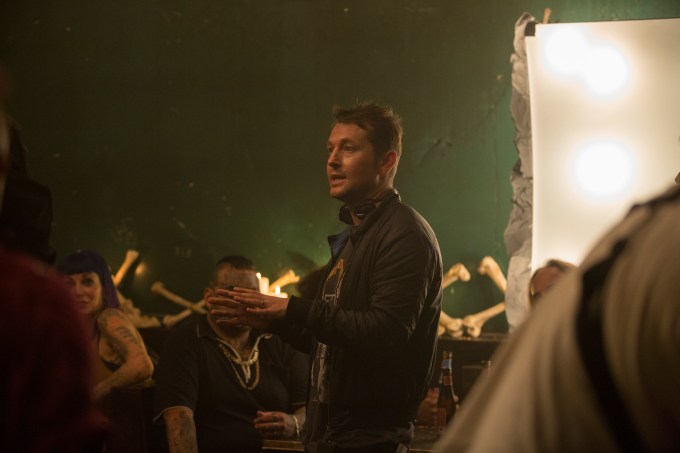
Leigh Wannell
Leigh Wannell: I’ve lived in L.A. for 12 years now, so I no longer care about Sydney-Melbourne. We shot this film in Melbourne but we actually edited in Sydney.
I was in Sydney for a few months and I absolutely loved it. I insisted on living in an apartment on Bondi Beach, which was not practical at all to the location of the editing room, but I didn’t care because I was like, “Look, if I was going to walk on ice, then I’m going to tap dance.” If I’m going to live in Sydney, I want to live on Bondi Beach.
TechCrunch: So the big science fictional idea of Stem, where did that come from?
Wannell: The idea really just came into my head, the way all my ideas do. It’s a very random process, and in its randomness it’s frustrating, because I feel like I’m always trying to think of movie ideas. And most of the ideas aren’t good, and they instantly get filed away in the drawer for terrible ideas.
Every now and again, something will pop into my head when I’m driving or I’m in the shower, you’ll just get an image and it stays with you. It doesn’t have to be much, it doesn’t have to be a story, it could just be an image. But it won’t leave your head and that’s when you know you’ve got something.
That’s how this started. It wasn’t like I read a magazine article about where tech is going. I was in my backyard, I remember that, and it was a nice day like this, and I just suddenly had this image of a quadriplegic in a wheelchair who stood up out of the chair and was being controlled from the neck down by a computer. That image and that scenario wouldn’t leave my head and I started reverse engineering a story into it. I kept writing away and making notes and then, cut to many years later, I’m sitting here talking with you.
TechCrunch: It’s interesting that it came from your imagination, because in some ways it feels very prescient. We had our own robotics event a couple of weeks ago and one of the big moments on-stage was someone in a wheelchair who was able to take a few steps thanks to an exoskeleton.
Wannell: So the exoskeleton that helps people with paralysis walk and move, this movie is the internalized version of that, where it goes one step further and there’s nothing exterior. It’s a chip.
It has been interesting to watch the world catch up to my script. Because when I wrote the first draft of this script, automated cars and smart kitchens were still science fiction. And in the ensuing years, they’ve become ubiquitous. I mean, my wife’s car parks itself and talks to her. And my daughter thinks it’s perfectly normal to have a voice talking to her in the kitchen, and she asks it to play songs and it does. So in a way I feel like I’m living in the world of the movie I wrote all those years ago.
TechCrunch: And when was that?
Wannell: God, the first draft was probably at least six years ago.
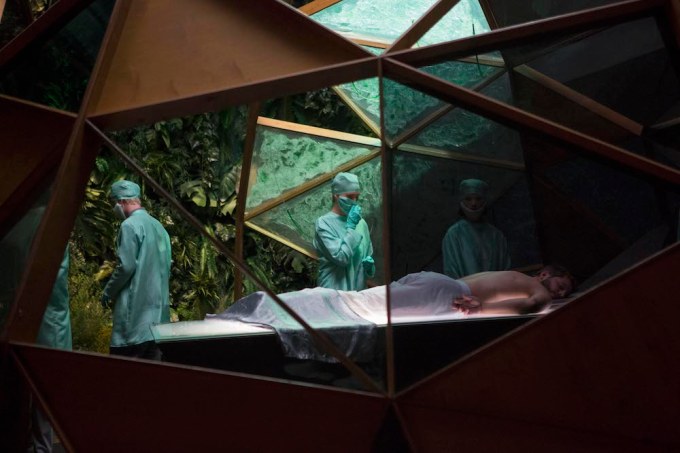
TechCrunch: You said a lot of ideas will come to you, and you’ll think: Some of these are bad, some of these are good. Obviously, you’re known for horror, so in this case, when you think of a science fiction idea, does that create any trepidation?
Wannell: There was a bit of trepidation on my part as I was gearing up to direct the movie. Not so much when I was writing it. But I started to worry about science fiction fans because I’m very well-versed with horror fans, I’ve been fortunate enough to meet a lot of them, I feel like I’m in that community, and I was a horror fan myself. But I realized that science fiction has its own community of these staunch fans who pick apart things like Star Trek and Star Wars. And I did remember having a moment where I thought, wow, are they going to see this and think that I’m a fraud, that I’m a tourist in this world?
I’ve just gone through a two week trip around the country, screening the movie in different cities, and afterwards I’ll always chat to people. And in the acceptance of the movie, I realize that these genres, they’re not the province of any one type of person. What I feel like science fiction fans respond to is just people trying to hit them with something new, something they haven’t seen. And if you do that you’ll be okay.
TechCrunch: When you were directing, did you feel like you were using a different skillset?
Wannell: The mechanics of making a horror film are so specific that I obviously wasn’t using any of that. Those quiet moments in a horror film where you really lean on the anticipation of things, this movie wasn’t using any of that. But I felt like some of the rhythms and filmmaking beats that I’d learned in horror, I think they’re just naturally ingrained in me.
So, for instance, I liked creating moments of silence that were suddenly punctuated by action. And I think I must be subconsciously looking for that vocal reaction that you get from a horror film. It’s almost like I was putting those horror beats into a sci-fi context: Build, build, catharsis. Build, build, catharsis. So maybe that’s in there, just ingrained.
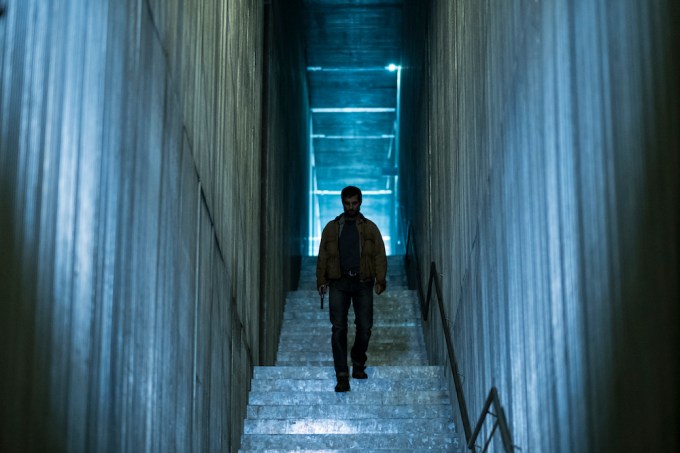
[Skip the next few paragraphs if you don’t want to be spoiled for an early scene in Upgrade, as well as the general direction of the film.]
TechCrunch: That’s certainly true to my experience. For a lot of it I was incredibly tense, and the moment when his head gets cut open, I just screamed.
Wannell: [laughs] In the operation?
TechCrunch: No, in the first kill.
Wannell: Ah, yes, the Pez dispenser!
TechCrunch: God, yeah. That was very upsetting.
Wannell: If you look at that scene and you analyze the structure, there is kind of a horror-esque metronome to it, where it’s quiet, it’s tense, and then there’s an explosion of something.
And in watching it, it’s been interesting to see that that scene gets a vocal reaction. It’s not the same reaction that a horror movie gets, that sort of scream in the audience, but it’s almost like an adrenaline rush, and when he gets up off the floor, I see people clapping along. I’m like, “Oh cool, this is a spectator sport, they’re getting into it as participants.”
TechCrunch: When I read the description of the film — obviously, the marketing is emphasizing this dystopian, almost horrific element, but you still think, “Oh, he’s basically going to become this superhero, and there’s maybe going to be this dark side to it, but it’s still going to be this ultimately triumphant story.” Whereas throughout the whole film, there’s this darker undertone that feels very different.
Wannell: I feel like the superhero version of this movie where somebody is given something — a power or a computer chip, whatever it is — that’s been done, especially in this age we live in, it’s been done a lot. So I found what was more interesting was to do the Taxi Driver version of this, to do the version where you realize the bad guy is in your body and the fight is not between you and external forces. It’s actually two entities fighting over the same physical body. That was interesting to me.
[End spoilers]
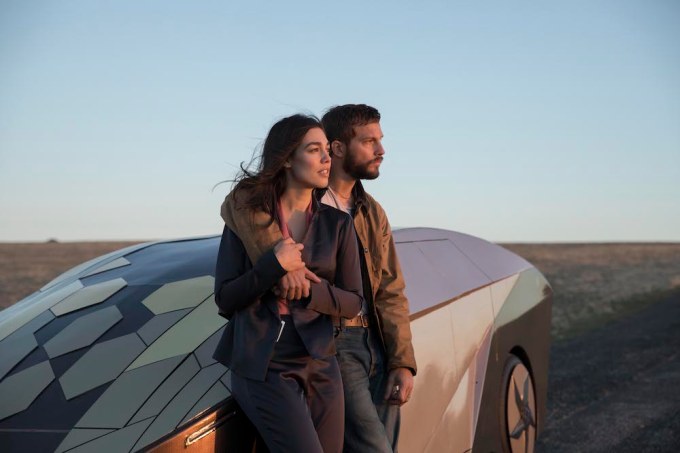
TechCrunch: One of the things you also mentioned in the press materials was this idea of having the freedom of an independent film but also having the scope of a larger science fiction film. I don’t know what the budget was, but I assume it wasn’t Avengers-scale.
Wannell: [laughs] Very low.
TechCrunch: What was the overall approach you took to saying, “Well, we don’t have all that money but we’re still going to try to build a world that has scope”?
Wannell: It’s just been a real goal and a dream of mine to do that. To make a movie that enjoyed the worldbuilding of sci-fi but took advantage of the creative freedom of an independent. The problem is that one is supposed to cancel the other out. You’re supposed to need studio money if you’re going to go off and make the future-set action movie. So I really was trying to have my cake and eat it, but I was obsessed with doing it.
As a model, I used ‘80s sci-fi films that I grew up with. I used the original Terminator as a great example, because if you really study that movie scene-by-scene, the science fiction and the tech is doled out very judiciously and sparingly. It’s kind of this lean-and-mean, slash-and-stalk movie that is dressed in this sci-fi skin. And I loved that.
I feel like, if they can achieve that sort of sleight of hand in the ’80s, then we could do it now. Especially with the new advantage that they didn’t even have back then of CG. We could use CG to augment some of the scenes. We couldn’t go bananas with it, but we could utilize it at certain moments. And I guess I’m too close to the movie, I’ve spent too long with it to know if we really succeeded, but I’m hoping that audiences feel like they’re watching a bigger movie, you know? That they’re part of a bigger world.
TechCrunch: Right, and there’s a couple of things in the beginning that feel very big —
Wannell: Like, here’s the world!
TechCrunch: Which, if I go back clinically and watched it, I would see that those are doled out very strategically. But it does the job. And it also is an interesting constraint because it means that in a lot of the other scenes, you have one or two science fictional elements, but you’re using primarily a real world location or set, rather than a created world.
Wannell: Absolutely, and that was something that was a very conscious decision. Not just budgetary, but a creative decision for me was: Let’s set this movie in the very near future. Let’s build a world that the audience can see themselves in.
Also, the world doesn’t change completely overnight, it happens incrementally. In 30 years time, you’ll still have buildings from the 1800s in New York City. They’re not going to knock them down and build a glass tower. So what you’re going to end up in 30, 40 years is a landscape in Manhattan that is the future sort of jammed on top of the past and it’ll be this hybrid.
And people will still be driving older cars! That’s another thing that you see in a lot of future movies, all of a sudden everyone on the road is driving the future car. And I’m like, well no, there will still be people 20 years from now driving around in early ’90s Hondas, crappy cars, you know? That scaling of the world was important, but a bonus prize was that it helped us budgetarily.
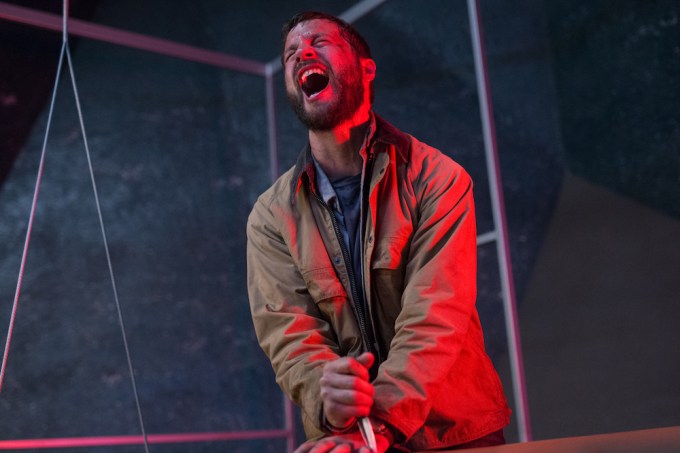
TechCrunch: You mentioned that this is something that you started writing six years ago. In that time, the technology has evolved, but also the ways in which we talk or think about disability, and the ways we talk about being quadriplegic or paraplegic has changed. To what extent was that part of your research, things like talking to disability activists?
Wannell: I didn’t talk so much to activists. When I was writing the film, I wanted the idea that a chip could cure paralysis, I wanted that to be a tangible thing and I talked to a surgeon and he said, “Look, what you’re talking about is hypothetical, but in theory, it could be done. That gap between our brain and our nerve endings could be bridged by a computer.” And that was great to walk away with, the knowledge that the tech was credible.
Certainly when we were preparing to shoot the film, we took the quadriplegic side of it very seriously. Logan [Marshall-Green], who plays Gray, he worked with a guy who was a quadriplegic who was nice enough to spend a lot of time with Logan, share his life with him, talk to Logan, let Logan see what his daily rituals were like, let him actually use a chair.
And Logan had a lot of integrity about that. He felt he owed this gentleman that he had worked with the responsibility of portraying that realistically, and he was really watching it, the way he held his hands. It’s not a long moment in the film that he spends as a quadriplegic, but it was important for us for that moment to have as much integrity as anything else in the film. Especially with something that in real life, people are experiencing. You don’t want to push back at them some wonky cinematic version of the real thing.
TechCrunch: Part of what I’m getting at is, is there’s this opening image that you mentioned of him rising out of the chair. It’s this incredibly moving scene for him because you’ve been through all of these terrible things with him. But at the same time, you can imagine somebody who is quadriplegic watching the film and you don’t necessarily want them to look at themselves and think —
Wannell: Them thinking, “Oh, you’re presenting this as triumphant, as if that’s much better.” Yeah, that’s interesting, that is part-and-parcel of putting films out into the world, isn’t it? The world reflects back at you and I think you just have to take those slings and arrows. Nothing was done with any malice.
And I don’t think we were trying to present the idea that quadriplegia is this hellish situation that only being able-bodied can cure. What I think we were doing is speaking to the story of a guy who hates technology becomes technology. The way that we were enabled to do that in the story was through his condition, his quadriplegia. So it’s the result of an accident, he’s given this chip, and now he’s completely reliant on it, you know? It’s totally a story point for us.
TechCrunch: And again, without getting into too many spoilers, you said that this is the Taxi Driver version of the story. How much of that was trying to express your own concerns about people becoming more automated?
Wannell: I think a lot of it. First and foremost, I’m trying to tell this genre story, I’m trying to build a unique movie. And then the themes and the questions of the film sit underneath it.
But I have a foot in both camps with technology. Especially in researching the script and reading books by Ray Kurzweil and authors that talk about the Singularity and the point at which humans and tech will merge. Because I didn’t want to make a robot film. A robot film has been done before and I wasn’t really interested in that. I was interested in human beings putting tech into their bodies voluntarily. That was something I felt I hadn’t seen a lot of.
Through my research and reading these books, I saw both sides. I saw the wonderful side of our reliance on tech in regards to medicine. If we can install something in our bloodstream or our bodies that cures cancer, that’s obviously going to be an amazing, wonderful thing. But there’s the other foot in the other camp, which is our overreliance on automation. I’m wondering if our cars do the driving for us and our kitchens do the cooking, are we actually designing ourselves into irrelevance? That’s an interesting road to look down. It seems to me the human instinct is to always make things easier. We’re always leaping towards convenience: “Oh, wouldn’t it be better if a machine could do that?”
I’m wondering where that road ends. The movie was definitely a reflection of that, too.
TechCrunch: The last thing I’m going to ask, which I think I’m sort of required to ask, is to what extent is this meant to be a completely standalone experience? Have you thought about a potential sequel?
Wannell: I haven’t. The thought enters my mind and I push it away. Because this is an independent film, and it’s really hard in today’s media landscape to get people to pay attention to things. We’re releasing the movie in summer, surrounded by giant movies. I can’t imagine what the marketing budget for the new Han Solo movie is. To compete against that is almost foolhardy, so I feel like planning a sequel is an assumption of success that I’m not ready for.
Sitting there being vexed about where to go with a sequel would be a great problem to have.
TechCrunch: Well, it certainly doesn’t feel like a movie that was written with a sequel in mind.
Wannell: No, it definitely wasn’t. I remember when James Wan and I did the first Saw movie, a lot of people would say to us, “Well, you left the door open for a sequel.” And we would say, “No, we literally closed the door!” We thought it was a nice ending. Little did we know that the producers had other ideas once the film was a hit.
To us, the ending to that movie, in our opinion, was the very definition of a cut to black, no more story. But then we got a lesson in commerce.
from TechCrunch https://ift.tt/2JkaZDf
via IFTTT
No comments:
Post a Comment